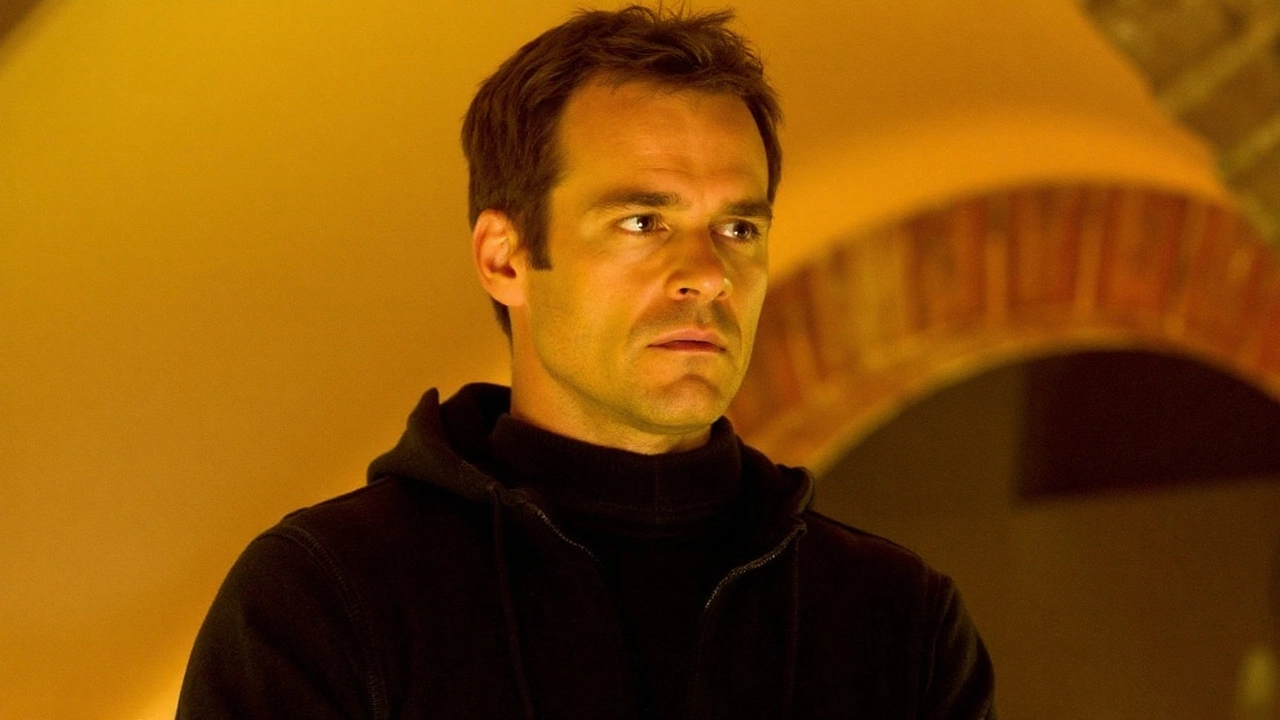Inside the finale setup: a bullet, a vault, and a code
A gunshot drops Angel Batista, and the room goes cold. That’s the spark for the Season 1 finale of Dexter: Resurrection, where Michael C. Hall’s vigilante wakes up boxed in—literally—inside Leon Prater’s top-secret vault. The episode is titled “And Justice for All…” and the stakes are exactly that: justice, or whatever version of it Dexter can claw out of a steel room with no obvious way out.
The exclusive sneak peek sets a taut mood. Dexter moves with that old, clinical focus, rifling through drawers and dead-quiet hardware while the clock in his head screams. He’s not alone in the ways that matter. The memory of Harry, played again by James Remar, arrives like a conscience with a scalpel—cool, blunt, and practical. He nudges Dexter toward a plan: find the code, own the room, turn the trap into a tool.
The complication lands fast. Tucked behind false panels and locked cases, Dexter finds Prater’s files—an archive of killers. Names. Methods. Photographs. Timelines. The kind of paper trail that can end a life without a single fingerprint. For Dexter, that cache is either a noose or a key. Destroy it and erase leverage; keep it and inherit a map of predators. Either way, it’s explosive.
This finale arrives after a season of relentless motion. Dexter resurfaced, followed Harrison to New York City, slipped past law enforcement, and—because he can never resist the gravity of darkness—embedded himself near a group of killers. The turn was inevitable: a face-off with Leon Prater, played by Peter Dinklage with a patient, surgical menace. Prater shoots Batista—a blow that looks fatal—and then cages Dexter inside a vault that seems built to end him. It’s a setup that puts both men exactly where they’re most dangerous: Dexter in a room designed to be read, and Prater outside, confident he’s already written the ending.
What’s making fans buzz is the double bind. Those files inside the vault could be used to expose Dexter’s past, connecting scenes and signatures that should never share the same folder. But the same archive could become a target list for future hunts, a perverse extension of the Code if Dexter decides to weaponize Prater’s work. That tension—evidence versus utility—has defined the character from the start.
Then there’s Harrison, the season’s ghost heart. Dexter’s chase to New York wasn’t just paternal instinct; it was a test of whether the darkness skips a generation or simply changes shape. The finale puts Harrison’s fate in the crosshairs without spelling out where he lands. Is he bait? Is he a partner? Or is he the line Dexter refuses to cross this time? Any one of those choices could blow up the fragile logic Dexter uses to live with himself.
Prater’s vault isn’t just a physical puzzle. It’s a manifesto in 10-digit combinations and airtight drawers. The sneak peek’s detail work—labels, cross-indexed binders, small tells on the locking mechanism—suggests a room built by someone who expects to be challenged and expects to win. That puts pressure on Dexter’s methodical side. He has to read Prater’s mind fast: where would a man like this hide a master code? What redundancy would he never admit he needs? You can feel Harry pushing him to think like a hunter, not a trapped animal.
Angel Batista’s shooting changes the emotional temperature for everyone still standing. Whether viewers knew Batista from the early years or came to him through the revival, he’s a connective thread to the life Dexter pretends he could have had. Removing him is not just a plot twist; it’s a message. It clears space for Prater and Dexter to define what “justice” means when both men kill, but only one of them believes he’s balancing a scale.
The episode title, “And Justice for All…,” isn’t subtle. Dexter’s Code has always been a workaround for a justice system that misses monsters who hide in plain sight. Prater’s archive flips that mirror. If he can catalog predators with this much detail, does he see Dexter as one specimen in the collection—clever, organized, thrilling—and nothing more? That dehumanization cuts both ways. It also hints at how Prater might use those files: not just to expose, but to prove a theory about what people like Dexter are.
In the wider arc of this revival, the finale’s promise feels blunt in a good way: be emotional, be bloody, be decisive. The original run taught viewers to expect a trapdoor. This time, the show seems more interested in consequences than clever escapes. But the sneak peek says one thing clearly: if there’s a way out, Dexter will try to turn it into a way forward.

What to watch for as the vault door ticks
- Can Dexter crack the vault’s master code in time, and what does that say about how well he understands Prater?
- Do Prater’s files get burned, buried, or repurposed—and who ends up holding the most damaging evidence?
- How does the fallout from Batista’s shooting reshape the map for cops, targets, and anyone still loyal to Dexter?
- Where does Harrison land when the dust settles: protected, endangered, or irrevocably pulled into the dark?
- Does Prater go public, or does he force Dexter into a private reckoning that leaves no witnesses?
One more angle worth tracking: allegiance. The season has been crowded with uneasy partnerships—the kind that last exactly as long as they’re useful. In a finale about escape, the quiet question is who decides not to run. If Dexter walks out of that vault, it will be because he turned his enemy’s system into his own. If he doesn’t, the system wins. And that, to be fair, is the point of a vault.
The sneak peek doesn’t spoil the ending, but it does narrow the lane. Dexter needs a code, a plan, and a split-second choice about the files that can either bury him or buy him time. Harry’s voice is still there, compressing years of lessons into a few steady lines. Prater’s design is still there, daring Dexter to reach for the wrong lever. Somewhere in that standoff is the finale’s answer to its title: justice, for all—or for no one.


